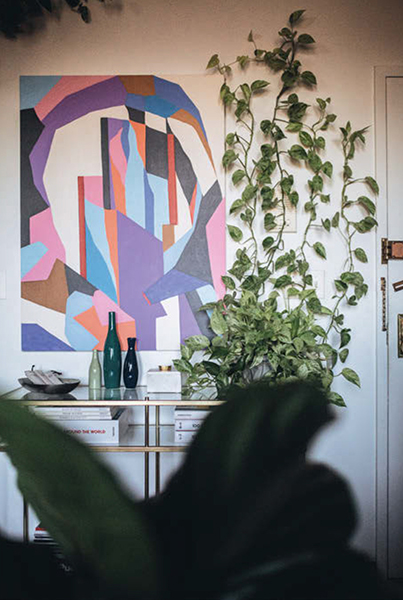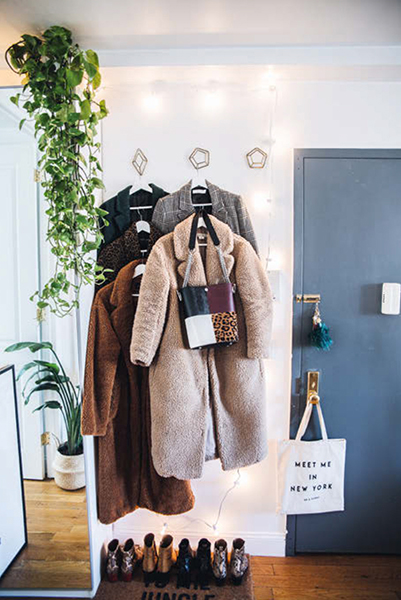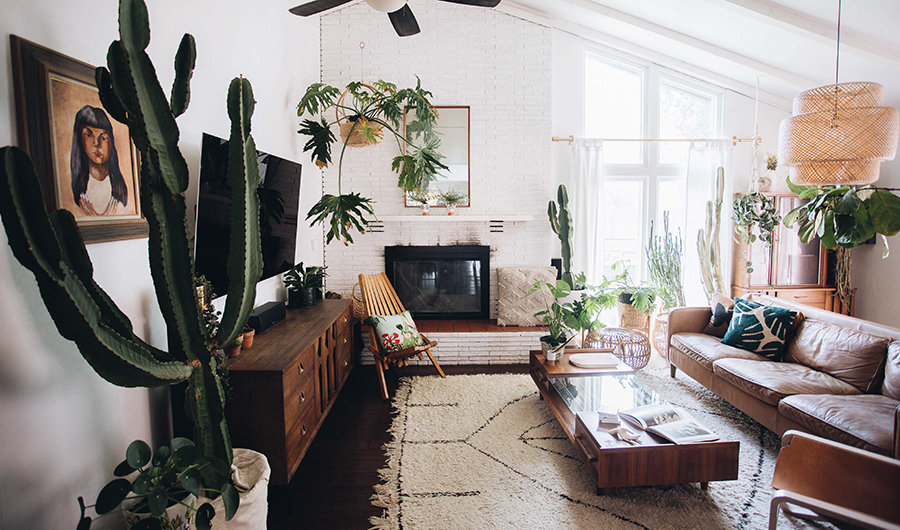
chapter 6
ROOM-BY-ROOM PLANT GUIDE
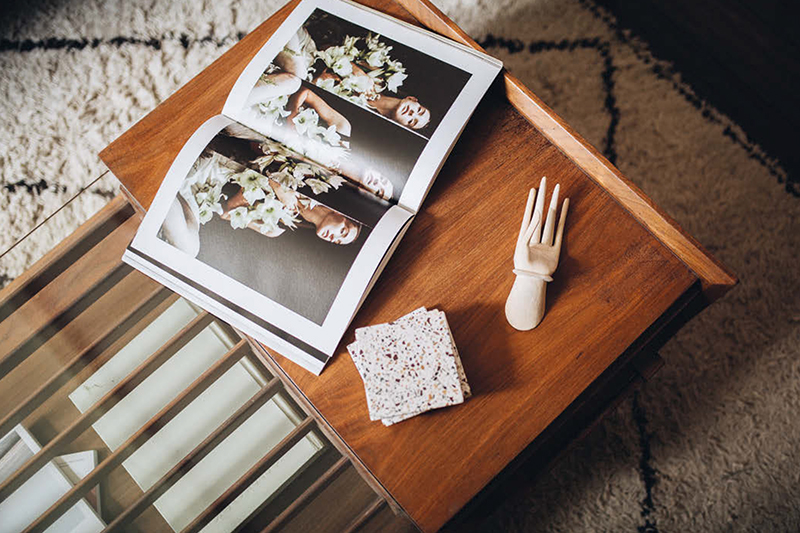
Living room detail in the home of Tish Carlson in Albuquerque.
6.1
the living room
The living room is often the biggest room in a home, with the greatest abundance of natural light. These factors make it an ideal spot for houseplants. In other words, this is the place to go really wild with plants!
Keeping in mind the space you have and the light conditions, opt for any kind of plant that speaks to you. The living room is where a large, mature statement plant has the most potential. Consider a full-grown rubber tree, a tall fiddle-leaf fig, or a big palm tree. Sometimes a single large plant will suffice, but if you want more, go for a variety of leafy plants, such as Calathea, ferns, pothos, or varieties of philodendrons placed in different corners. A big Monstera deliciosa will be more than happy in a spacious living room, too. Plants are also a good way to camouflage or frame devices, such as a TV, that are not so decorative. Surrounded by plants or plant shelves, any TV will definitely look much cooler and wilder!
Which Plants Will Make a Statement in Your Living Room?
A list of green suggestions to make a botanical statement.
MONSTERA DELICIOSA VARIEGATA
The variegated version of the popular Monstera plant has become something like the holy grail of the Plant Tribe. This rare variety is hard to find, and even when you find it, it’s pretty pricey. But if you’re lucky enough to come across one (or to receive a cutting from a plant friend), don’t think twice! Go for it, and put this botanical gem in your living room. Place this beauty in a warm spot that gets bright indirect light and keep it moister than you would its non-variegated cousin. The only risk is that your friends will turn green with envy!
FICUS LYRATA
The fiddle-leaf fig tree makes a great statement plant. For a jungle vibe, go with a mature plant that has big leaves. To encourage fullness, prune the top of the fig, which will force branching on the lower stem. To strengthen the stem, simulate a tropical storm by shaking your plant every now and then (in nature, the wind does the trick). Figs need bright indirect light for healthy growth, and you should clean the leaves regularly to keep them healthy and shiny.
PHILODENDRON ‘PINK PRINCESS’
With its pink leaves, this variegated philodendron is a real eye-catcher, although it is a rarity in plant shops. It is also the perfect addition to a colorful, tropical decorating scheme. A climber, it needs a trellis or other support to vine. Make sure it gets bright indirect light, and keep it on the moist side, with good drainage. Enjoy the pink variegation but make sure to keep it balanced—the pink part has no chlorophyll for the plant to photosynthesize. So you don’t want too many all-pink leaves (if that occurs, prune the plant back to the last area of balanced variegation).
STRELITZIA
The famous bird-of-paradise is a beautiful and lush tropical plant that loves bright natural light. Even though this plant hardly ever blooms indoors, it’s a real highlight because of its large and long leaves, which sway in a light breeze. Indirect light and some direct sunlight, regular watering, and warmth are optimal for the Strelitzia. But watch out: This plant grows quickly and gets pretty tall, so make sure you’ve allowed enough space for it!
TALL CACTUS OR SUCCULENT
If you prefer a model plant that doesn’t branch out too much, opt for a tall cactus or succulent, such as a Euphorbia trigona (African milk plant). Keep in mind that these plants require lots of light, and they have thorns and spikes—if you have small kids or pets around, you might want to choose a leafy plant instead.
ONE FACT TO KEEP IN MIND:
Don’t forget that during the cold months of the year, the living room tends to be the most heated area in a home. The air will be drier then, so you must take simple countermeasures to avoid symptoms of drought: Up your misting game and give your leafy plants a daily spritz of filtered water (tap water will clog the pores and leave annoying watermarks on the leaves).
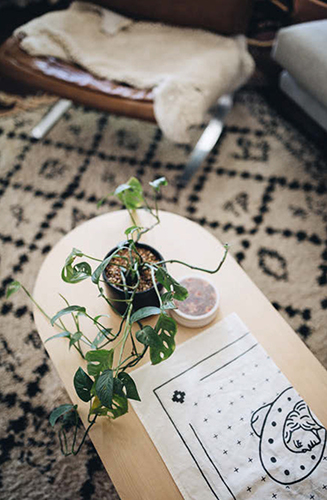
A branchy Monstera adansonii dresses this Albuquerque, New Mexico, coffee table.
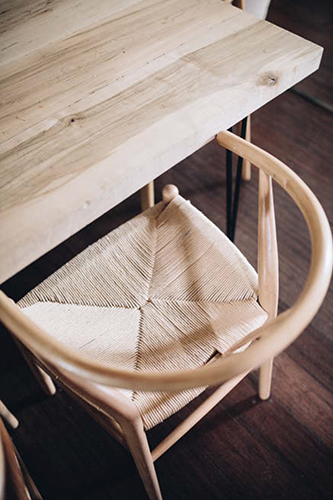
For an instant jungle vibe, go for mature plants that have big leaves, like this large Ficus lyrata.
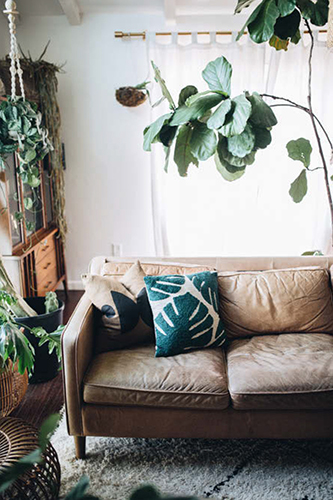
Natural materials like sustainable wood and wicker are a perfect match when decorating with plants.
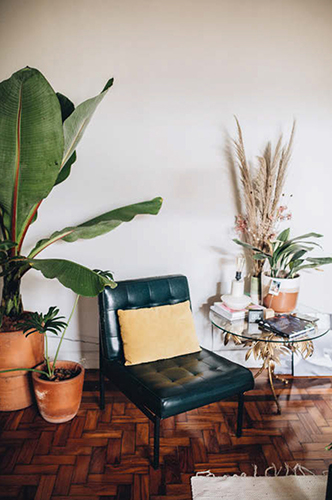
No need to add dozens of plants to get a jungle feeling in your living room: One tall banana plant and two smaller plants give this nook a green feeling. The dried bouquet and vintage palm leaf table add to its charm.
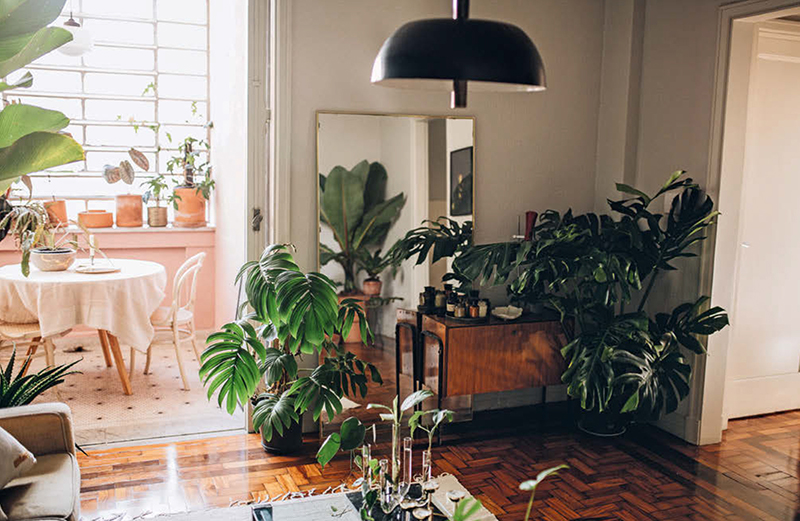
Imagine taking a selfie in this mirror: Lush plants, like this Monstera deliciosa (right) and Rhaphidophora decursiva (left), will frame your outfit of the day!
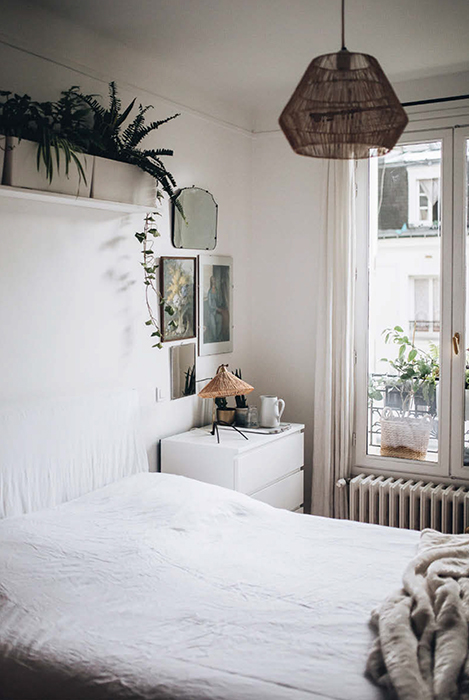
For a green shelf above the bed, choose ferns, snake plants, ivy, and trailing philodendrons to create a soothing effect.
6.2
the bedroom
Sleeping with Plants
Every time we post a picture of a beautiful bedroom filled with plants on Instagram, we get some concerned comments from readers who believe sleeping in a bedroom with plants is not healthy. Here’s why we feel differently: Plants respire as humans do, emitting carbon dioxide at night (the reverse of photosynthesis) and converting carbon dioxide to oxygen (by photosynthesis) during the day. Carbon dioxide (CO2) and carbon monoxide (CO) are often confused. The names sound similar, both compounds are colorless and odorless gases, and at high concentrations both can be deadly. In small amounts, carbon dioxide is relatively harmless, whereas carbon monoxide is extremely dangerous. Maybe this is the basis of the misperception.
The amount of CO2 that most plants produce at night is far less than the amount people and pets do. You could even say that sleeping with another person, in the same room or in the same bed, is less healthy (oxygen-wise) than sleeping in a bedroom filled with plants.
The benefits of plants in homes in general, and in bedrooms in particular, are countless. They make a room look more alive, and your bedside table brighter. Taking care of your plants can also help you wind down after a busy day. Studies have even shown that by simply touching the leaf of a plant for two minutes, you reduce your stress levels! For a healthy bedroom regime, don’t rely on plants alone, however: Good ventilation, fresh bed linens, a comfortable mattress, good pillows, and an extra blanket, if needed, help you sleep better and improve your overall well-being.
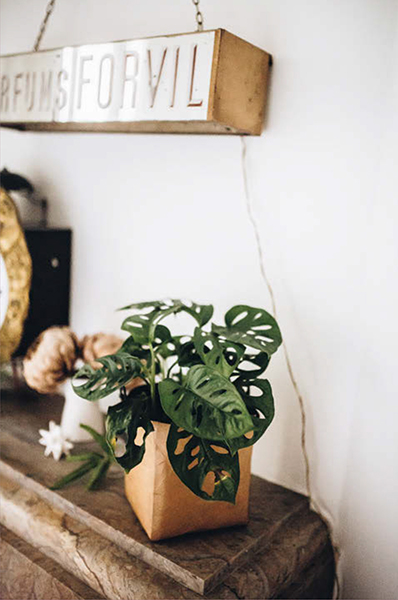
A small Monstera adansonii in the Parisian bedroom of Rebecca (see this page).
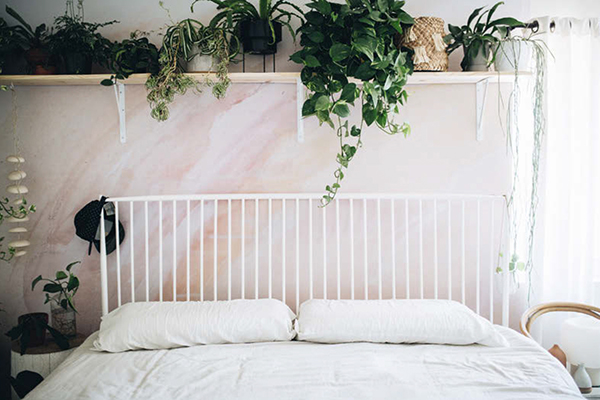
A floating plant shelfie above the bed features a pothos, a Hoya linearis, and a spider plant, among others.
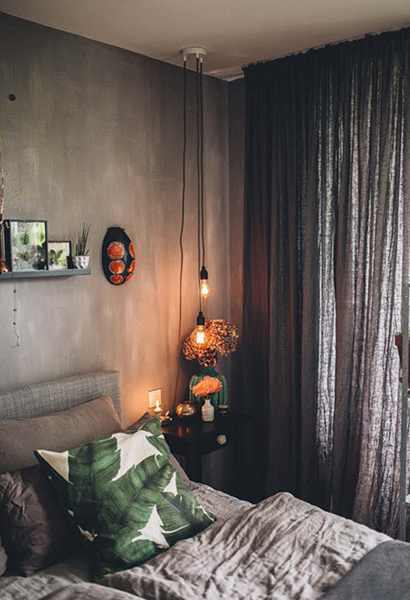
In bedrooms that are too dark for plants, you can use botanical prints—like this banana leaf pillow cover—to add a jungle vibe.
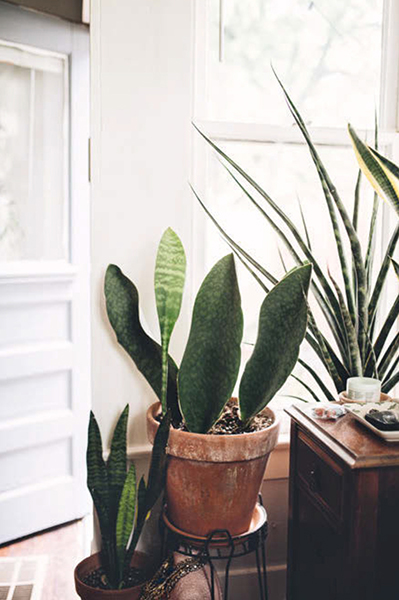
Four different snake plants peeking out while the Sansevieria masoniana (also known as whale fin snake plant) takes center stage.
Which Plants Are Best for the Bedroom?
As you would before choosing a new plant for any room in your home, first take stock of the light and temperature conditions in your bedroom. If your bedroom is cool and on the dark side, don’t pick a plant that requires lots of bright light and warm temperatures.
These are some of our favorite plants for the bedroom:
- The Sansevieria plant, also known as the snake plant, is a star in the bedroom: It tolerates low (bedroom) light and thrives on (reasonable) neglect. Did you know that snake plants even convert carbon dioxide to oxygen during the night? This has been shown by several studies and makes this plant number one in your bedroom!
- Aloe vera, a plant of many talents in the home, is a great choice for the bedroom. Not only does it have a sculptural look, it removes benzene and formaldehyde from the air, and its gel helps soothe your skin—in case you have no cream or lotion at your bedside. Just sayin’.
- Another all-around plant is the spider plant, or Chlorophytum comosum. It removes toxins from the air, is very easy to care for, and is non toxic to your pets. So all you pet owners out there, get some spider plants for the bedroom ASAP! Plus, when they grow their own little plant babies, hanging from long runners, they look cool and outer-space-y. So funky!
- For instant style, why not let a Philodendron vine grow along your bed canopy or on a wall or the ceiling near your bed? A great look, and the heart-shaped leaves add a subtle romantic touch! Perhaps you’re thinking of letting this air-purifying vine grow decoratively above your bed. Why not?!
- Areca palms are yet another great option for the bedroom. Why? Again, they purify the air and are nontoxic to your pets. In addition, they create an instant tropical vibe in your bedroom, transporting you to lush jungles while you dream away. Waking up is like greeting a new day in a tropical paradise! You’ll sleep like a baby!
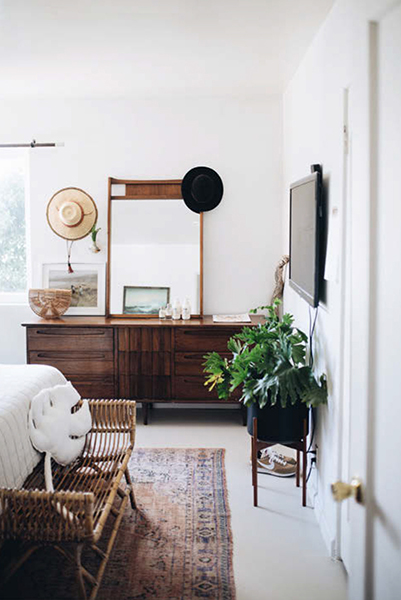
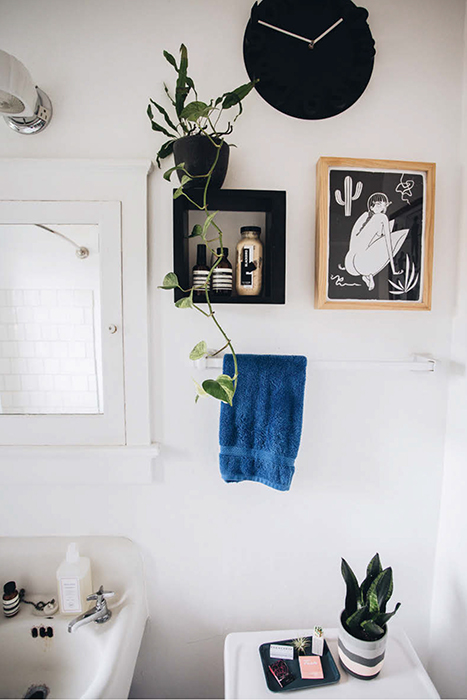
A snake plant and pothos pair neatly with the art in this Portland, Oregon, bathroom.
6.3
the bathroom
The Secret to a Sunday-Night Pool Party
When you think of the bathroom, you think of water. Along with the kitchen, it’s the place where you fill up your watering can and from which you set off around your home to give all your plants sips of water. But the bathroom is also a very convenient place to treat your plants to a nice shower and let them have their own pool party. The bathtub or shower is the ideal location to clean the leaves of your plants, soak the plants’ soil, and allow them time to get rid of excess water via the drainage holes in the pots. It’s refreshing for the plants, and if you carefully dry the leaves with a cotton cloth afterward, they’ll be fresh and ready for a new round of photosynthesis. When plants are dirty or coated with dust, the plants’ pores (called stomata), through which they take in carbon dioxide and release oxygen, become blocked, drastically reducing the leaves’ photosynthetic capacity. Rinsing the leaves with water mimics a tropical rainstorm, which some tropical plants, like ferns, truly love. It also washes away accumulated salts from fertilizer and discourages pests, such as spider mites, that thrive in dusty plants. After a shower, it’s important that you make sure the soil dries and doesn’t stay soggy wet, or the result will be root rot, the primary cause of dead plants. That’s also why you should never water your plants in a shower or bathtub if their pots lack drainage holes. It’s critical that the water not remain in the pots.
If your plants are in terra-cotta pots, you can fill the bathtub or sink with water to three-quarters of the height of your pots. Place the pots in the water and wait an hour, while the pots and soil soak up the water. Let out the water and allow the pots to air-dry on the outside before returning them to their usual spots in your home. This is a particularly efficient way to water succulents and cacti, which are susceptible to overwatering but whose roots need more water than you expect.
While you’re at it, why not turn your bathroom into a green sanctuary for your own private pool party, too? The only requirement is that the room has some natural light, because plants don’t grow without light (see this page). Place your plants on shelves on the wall or on the edge of your bathtub, hang them from the ceiling if you don’t have a lot of floor space, add a few on the shelf next to your toothbrush, or even place them in your shower caddy (as long as they’re not exposed to any gels and soaps, they’ll be fine). Light some candles, pour yourself a glass of your favorite drink, play some music, fill the bathtub or turn on the shower among your plants, and enjoy your party!
Humidity-loving plants like Aglaonema, Begonia, Boston ferns, bromeliads, golden pothos, Nepenthes, orchids, Philodendron scandens, spider plants, staghorn ferns, or Tillandsia air plants are ideal for this space.
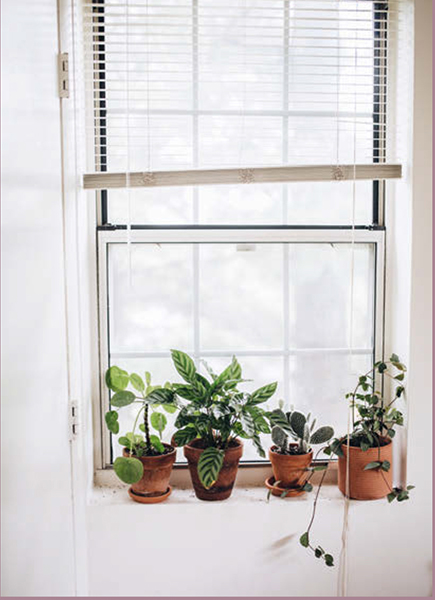
A Pilea peperomioides, a Calathea concinna ‘Freddie,’ an Opuntia microdasys, and a Peperomia angulata soaking up the sunlight in this Alexandria, Virginia, bathroom.
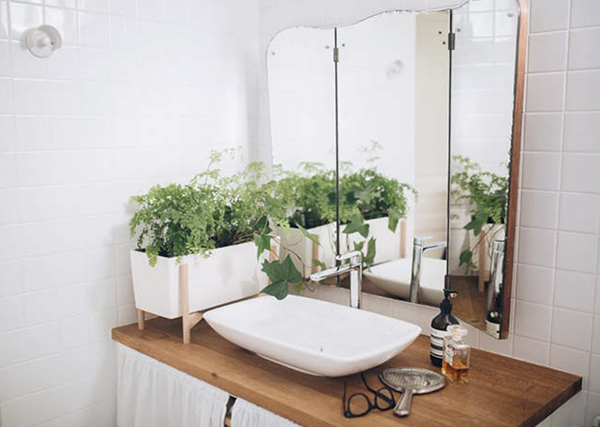
A maidenhair fern and ivy thrive in a plant box in the humid bathroom environment.
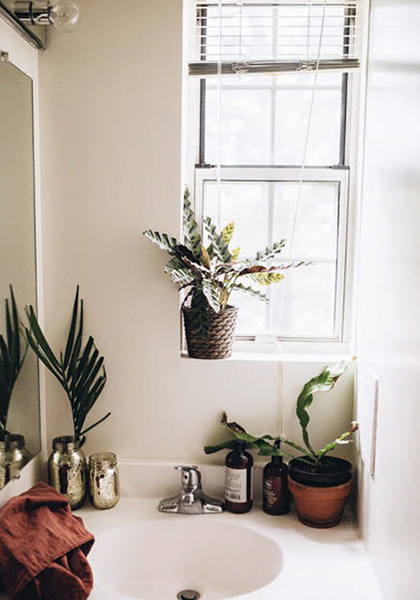
A Calathea enjoying the extra sunlight on a bathroom windowsill.
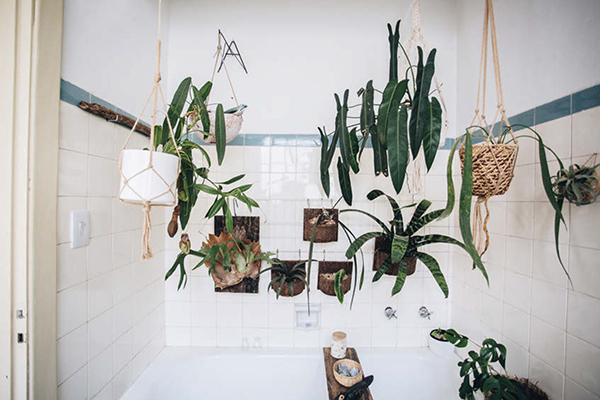
Philodendrons, bromeliads, and a staghorn fern float above the bathtub in São Paulo.
What If Your Bathroom Has No Windows?
If you absolutely must have plants in a dark bathroom without windows, invest in grow lights that can give your plants what they need more than anything else: full-spectrum light. Or go for a botanical touch in your bathroom that doesn’t require living plants: Hang a shower curtain decorated with a foliage pattern, add a Monstera leaf–shaped bath mat, install some palm tree–shaped wall hooks, or paint your walls a nice deep green. You can also rotate plants in and out of your bathroom to give them turns at a sunny window elsewhere. Just allow the plants to adapt gradually to each new light situation, as they may shed some leaves or suffer sunburn when the change is too abrupt. We don’t recommend faux plants, made of plastic or silk, because they don’t grow and because the world doesn’t need more plastic.
If you want to avoid unsightly water stains on your plants’ leaves, dry the leaves with a cotton cloth immediately after watering. If your water has a high concentration of calcium and other minerals, it can leave a calcium buildup or mineral deposits on porous terra-cotta pots. These are harmless to the plants and give the pots a charming rustic vibe, but they look ugly on leaves (and can possibly clog the stomata). It’s best to clean your leaves with a mixture of vinegar or lemon juice and water. Combine one part vinegar or lemon juice with four parts water, soak a cotton cloth in the solution, and wipe the leaves. The calcium should come off fairly easily. Repeat, if necessary.
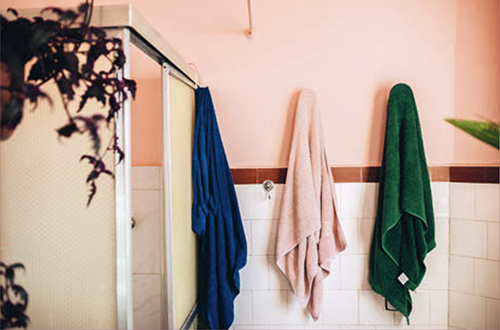
Color coding is a creative way to help organize a shared bathroom.
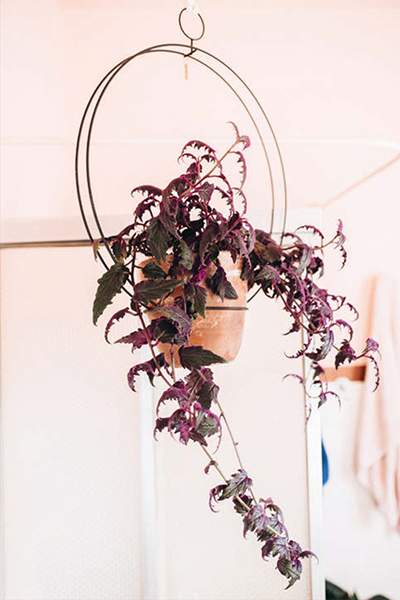
A hanging Gynura aurantiaca, also known as purple passion or velvet plant.
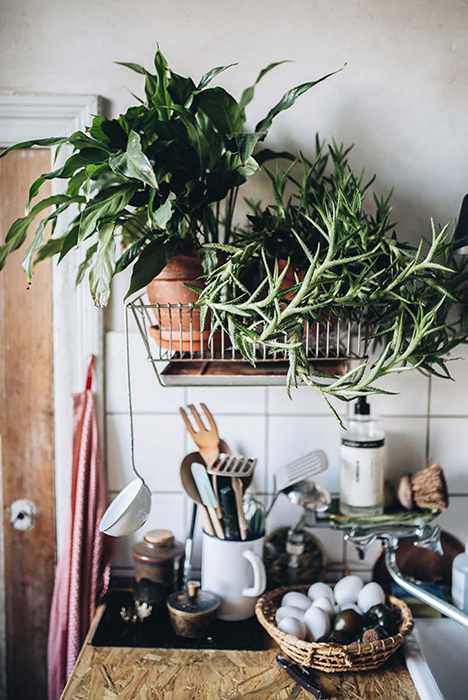
Herbs are a classic in the kitchen, but the warm microclimate in this room is good for other houseplants as well, like leafy greens and spiky succulents.
6.4
the kitchen
The kitchen is the heart of the house. People gather there, so it’s social and it can also be a perfect place for plants. When we cook and bake, we create a certain microclimate in our kitchens. Usually, the kitchen is the place where the temperature and the humidity are higher than in other rooms (except the bathroom). If your kitchen has good natural light, too, then you’re good to go for a really wide array of plants to add to the decor.
Bright light, high humidity, and warm temperatures are also the perfect conditions for tropical plants—so don’t rule out vining plants and exotics, too. The vines can even be suspended to create a green curtain on walls and ceilings.
Ideal Plants for the Kitchen
A windowsill garden of homegrown herbs—thyme, parsley, rosemary, sage, oregano, lemon balm, and mint—is a natural for this space. But what about some other interesting greens, for the kitchen’s wilder side?
CALATHEA LANCIFOLIA
This tropical beauty is commonly known as the rattlesnake plant and adds instant style and a jungle atmosphere. The oblong leaves feature beautiful patterns in shades of deep green and purple. The plant is native to the Brazilian rainforest and thrives in warm and humid environments. Place it in medium to bright indirect light, and keep the pots in your kitchen cooking—a rattlesnake plant loves warm temperatures and high humidity.
MONSTERA ADANSONII
This beautifully perforated plant, commonly known as Swiss cheese plant, grows fast and climbs well.
Place it close to your kitchen window, in bright indirect light, and give it support to climb and thrive. It’s very easy to care for: Just water it once the top of the soil has dried. Fertilize every other week during the growth period to keep it green and happy.
ALOCASIA × AMAZONICA ‘POLLY’
Commonly known as Amazonian elephant’s ear, Alocasia prefers semi-shade—perfect for darker corners of your kitchen. Water regularly to keep the moisture level balanced, and keep the area around the plant warm. Take note: For this plant, as for most tropical plants, tap water is too mineralized and will cause spots on the leaves, or even brown tips. Use filtered water or rainwater, when possible!
PHILODENDRON SCANDENS
Here’s a great choice if you want a climbing plant to line your walls, your curtain rod, or your kitchen shelves. Commonly called the heart-leaf philodendron, this plant has dark, velvety leaves that thrive in warm, humid places. Put the pot on your shelf and let the plant climb its way through your kitchen! This philo, moreover, is a known air purifier.
MARBLE QUEEN POTHOS
Another great option for a climbing kitchen plant, the Marble Queen pothos (Epipremnum aureum ‘Marble Queen’) is an easy-care plant that will grow even in low light and humidity. It will thrive, however, in bright indirect light and high humidity. Keep the soil on the dry side and you’ll have a happy plant.
AVOCADO PLANT
Instead of throwing pits and seeds away, why not grow new plants from them? (See this page.) An avocado (or mango) plant looks great in a kitchen. And if you eat lots of avocados, you might end up with a little avocado forest on your windowsill, and, hey, why not?!
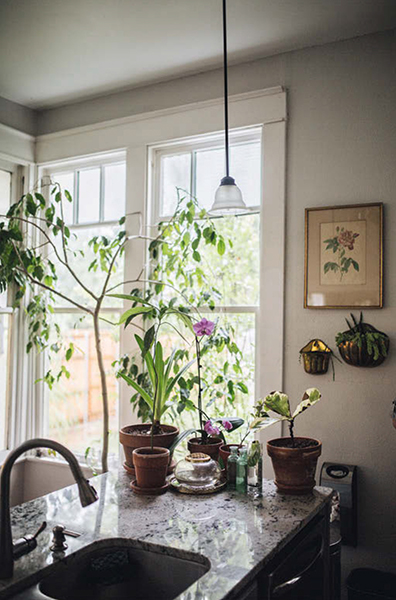
A pink orchid adds a touch of color to this stylish counter.
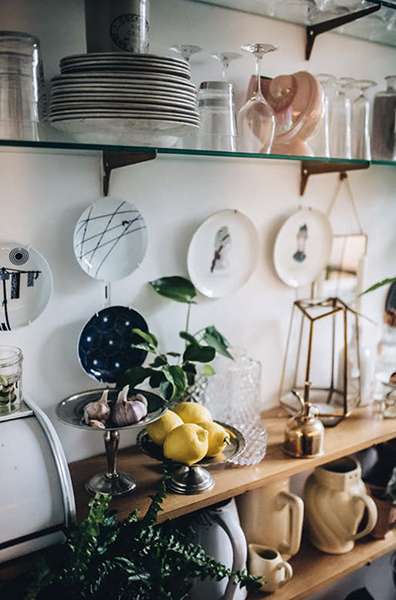
A fern and lemons create a still life in a Parisian kitchen.
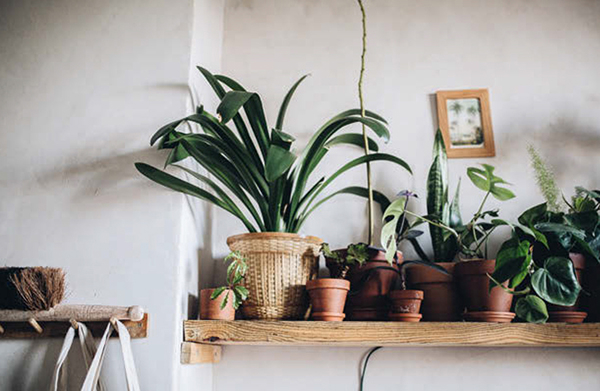
Why not try your hand at a little DIY and install a plant shelf in your kitchen?
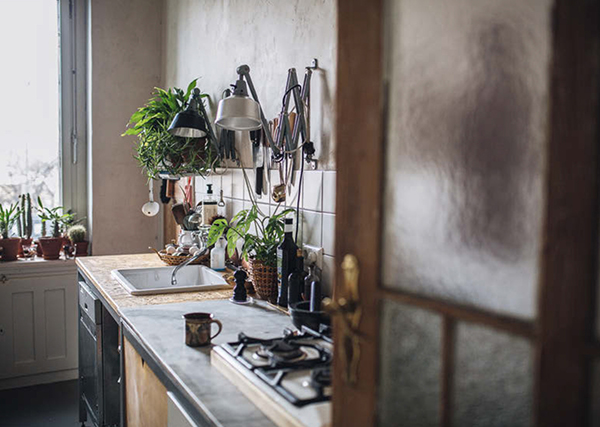
The sun-loving cacti in the windowsill, the leafy greens and spiky succulents in the wall-mounted basket, and the Monstera adansonii on the countertop make this kitchen come to life.
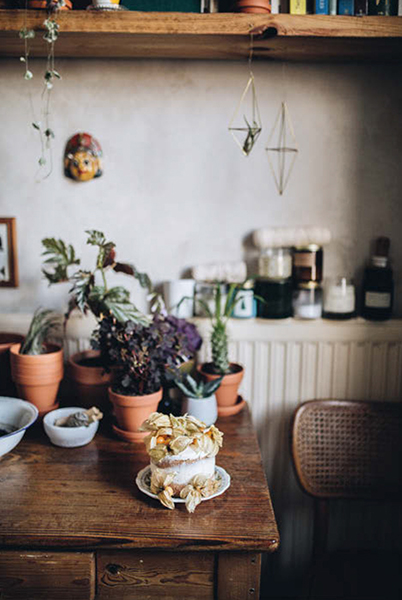
Plants make a kitchen more inviting and may inspire you to spend more time there as a result. They may even inspire you to spend more time cooking!
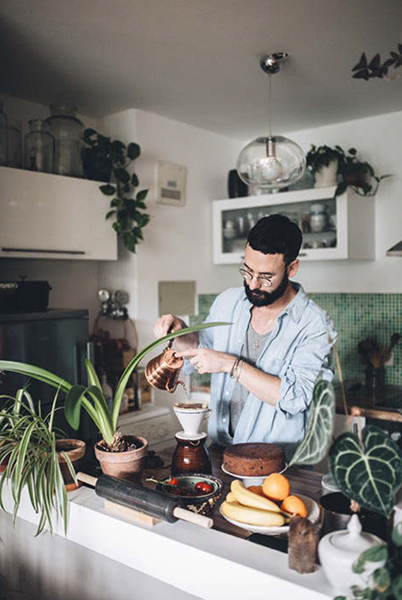
Start the day with freshly brewed coffee in a kitchen framed by plants.
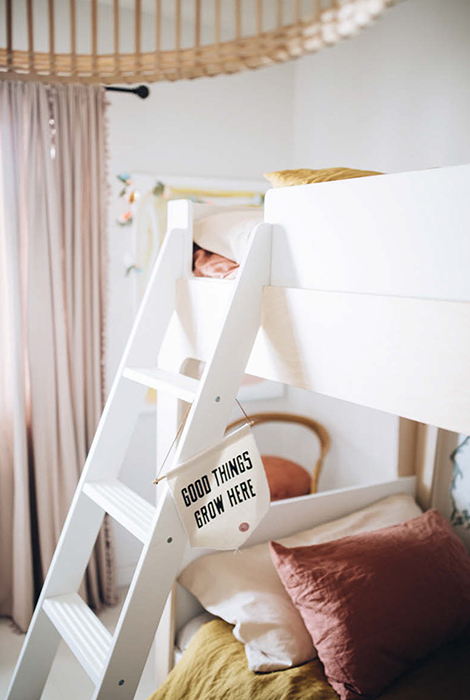
The motto of this home in Albuquerque.
6.5
kids’ rooms
Good Things Grow Here
Start them young! We believe that plants should be part of every room, especially our kids’ rooms. Growing up surrounded by plants teaches children valuable lessons about nature and the pace of growth. It’s also an opportunity to discuss how our plants, vegetables, and fruit are actually grown, and how they nourish kids’ little bodies. The presence of plants creates awareness, even for us adults, that a salad takes time to grow and that the green tomatoes don’t taste as good as the bright red, orange, or yellow ones.
Giving your kids responsibility for plant care is an excellent way for them to learn to be patient, to stick to a schedule (to water once every few days, for example), to trust their own judgment (this plant needs water now!), and to appreciate the results of their work. Most kids love having their own houseplants, and learning to care for them can become a family bonding experience. And what about digging in the ground, repotting a few plants, and making a mess? A kid’s dream! Go for fast-growing plants that can handle some extra water, and make sure all pots have drainage holes, to avoid root rot if eager tykes water the plants a little more than required. If you have an active family, make sure the plants are safely out of the way on a shelf or the windowsill.
When shopping for plants, involve your kids in the process of picking their new roommates: Do they love speckled plants, say, or the color of that cute variegated rubber plant, or do they prefer a prickly cactus?
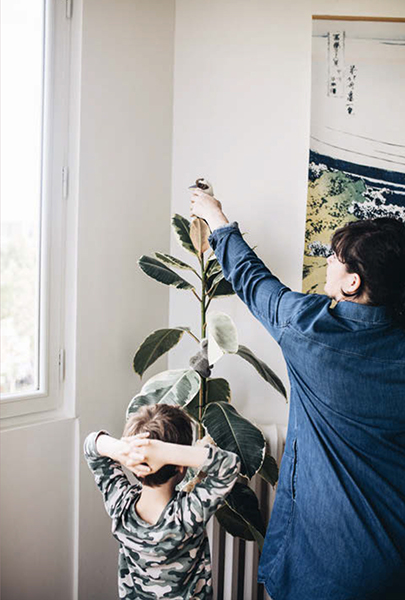
Aleksi loves decorating the variegated Ficus elastica in his room with some of his koala and teddy bears. His mom, Rebecca, helps add the “tree topper.”
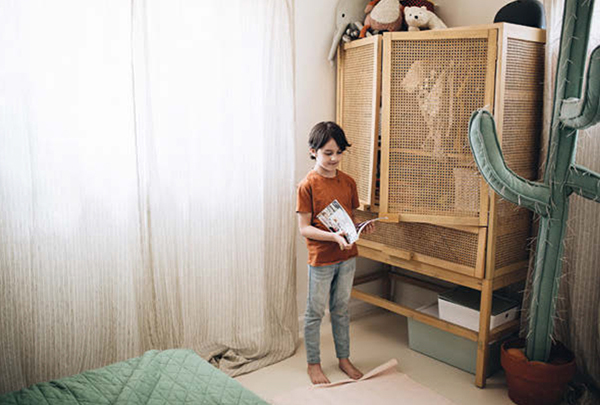
Green accessories and the tones of natural wood establish the color scheme in a cool, botanical-themed room.
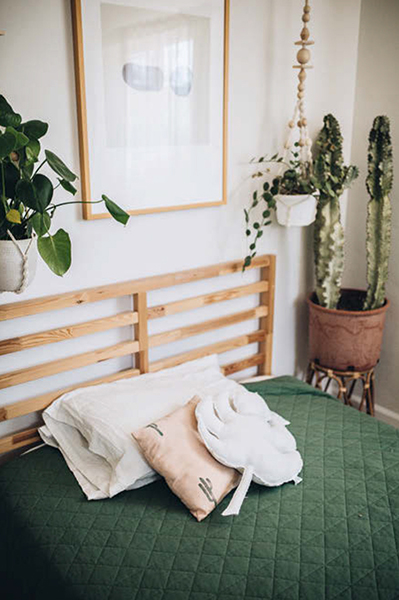
You are never too young to fall in love with plants. This child’s bed is surrounded by mature greenery and decorated with botanical motifs.
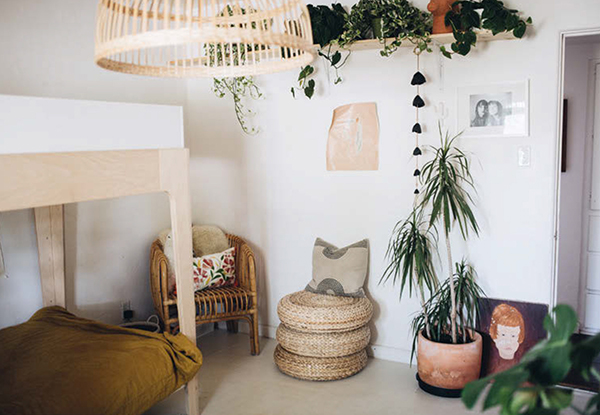
A plant shelf holds philodendrons and pothos, and Dracaena adds to the mix.
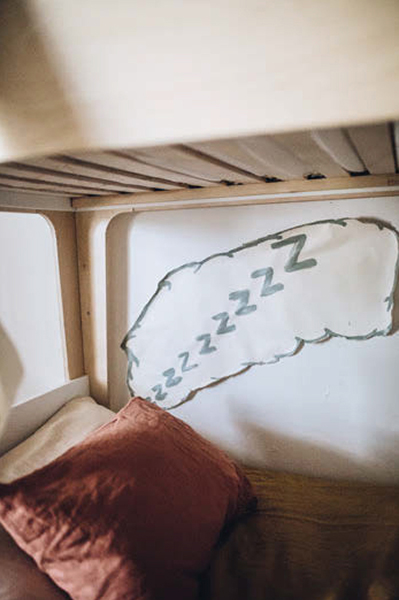
Sssshhhh, be quiet.
Growing tomatoes, sunflowers, or alfalfa sprouts in a kid’s room isn’t usually possible, but there’s always space for a few houseplants—here are some kid-friendly ideas.
PILEA PEPEROMIOIDES
Pilea, the Chinese money plant, grows rapidly and produces little babies that can easily be cut off and rooted. Pilea babies make cute gifts (they are considered tokens of luck) for friends, especially in customized, kid-decorated plant pots. Or let your kids grow an entire jungle of Pilea!
FICUS ELASTICA
Rubber plants are easy growers and—the bigger ones, especially—will make any space feel like a jungle. Make sure your child doesn’t break off the plant’s leaves, because the milky latex inside is an irritant to the eyes and skin. According to Rebecca’s son, Aleksi, the rubber plant is also good for decorating with your favorite plush toys (see this page).
TILLANDSIA
There is something magical about air plants; they grow without being potted in soil and survive with just a regular spritz of water. This allows for creative plant holders—shells, wire grids, vases, air plant hangers, LEGO creations, or toy figurines.
ASPIDISTRA ELATIOR
The cast-iron plant’s name implies it’s a tough plant, and it truly is. It doesn’t mind a bit of neglect, it looks all right in rooms that provide little light, and it can handle irregular watering and temperature fluctuations.
CYPERUS PAPYRUS
Commonly known as papyrus or paper reed, Cyperus is fun to grow. Cut off the top few inches of the stem and place the cutting upside down in a glass of water or well-drained potting mix. The leafy stem tip will be in the water or potting mix, and the leafless portion will point upward toward the ceiling. Roots and new shoots will form over the next few weeks, and soon you will have a new plant. When you have enough papyrus grasses, you can even try to make your own papyrus paper, as the ancient Egyptians used to do.
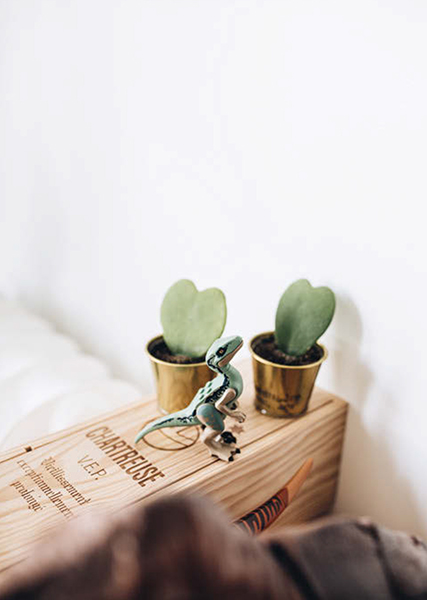
The dino is amazed by two sweetheart plants (Hoya kerrii).

A thriving Sansevieria trifasciata.
6.6
hallways
Hallways tend to be on the dark side. In most apartments, the hallway is in the back or along the side, with either no windows or low light. Keep that in mind when selecting plants. If your hallway has an abundance of bright natural light, feel free to pick plants that you like and that suit your interior style. If it’s dark, choose accordingly.
Which Plants Will Thrive in Your Dark Hallway?
Plants that can handle semi-shade are the best option for your dark hallway. Here’s a list of our favorites:
SANSEVIERIA
The famous snake plant comes in different variations if you’re bored with the classic look. Why not try the Sansevieria ‘Moonlight’ (sometimes called Sansevieria ‘Moonshine’), with its pale silver leaves? Snake plants can tolerate very low light and will add a green touch to dark hallways. In addition, their upright leaves ensure that, in small and narrow passageways, they won’t take up too much space.
RHAPIS EXCELSA
This plant, commonly known as the lady palm, usually grows in tropical forests under a canopy of larger trees; thus, it’s used to low light. It’s a great option if your hallway gets only low indirect light (but don’t place it in a corner with no light at all).
ZAMIOCULCAS ZAMIIFOLIA
The Zamioculcas zamiifolia, or ZZ plant, is perfect for low-light corners of your hall. Don’t overwater this plant, especially when it’s placed in a shaded corner. Make sure you have some space, as it tends to spread as it grows.
SPIDER PLANT
The spider plant, Chlorophytum comosum, is a fine option for any low-light area of your home. It’s also a great choice if you have limited space, as you can simply put it in a plant hanger.
LUCKY BAMBOO
Another great option for low light, lucky bamboo, Dracaena sanderiana, can be grown in water only, so you can arrange a few vases of lucky bamboo on your hallway table. Another reason this plant is great for a hallway is because it’s said to attract luck and good fortune. Yes, please come in!
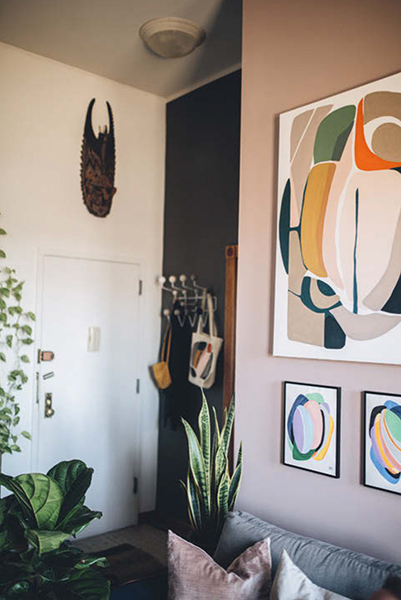
Sansevieria are staple plants for areas in your home that tend to be on the dark side, like hallways. They are happy in brighter light, but can survive in lower light conditions.
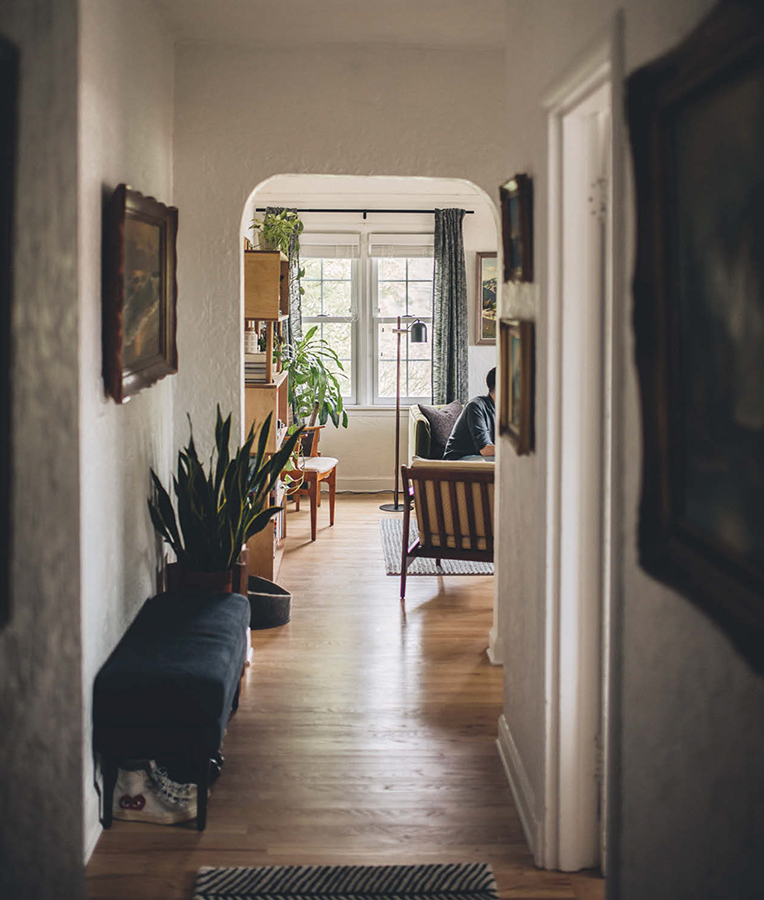
Hallways tend to be darker and narrow, so choose plants that can handle low light and do not take up too much space (such as snake plants).
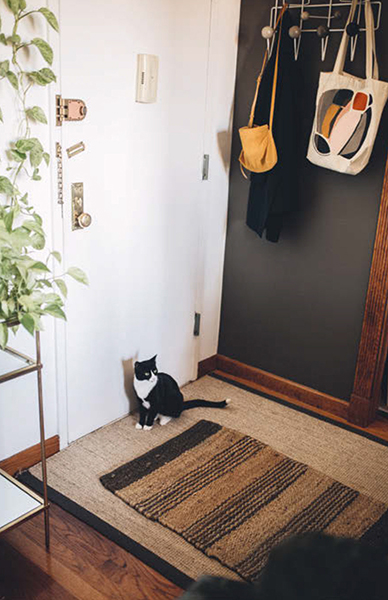
Pothos is a hallway favorite, as seen in these Manhattan (above) and Brooklyn (next) apartments.
